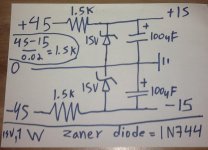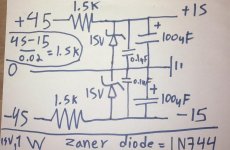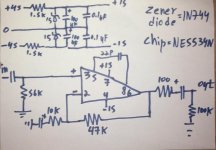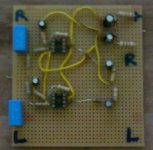.
the power amp (stereo reciever ) is 70's Marantz 2226
It has +- 35 DC , and I don't how to lower it to 15 + - .
i searching for the simple but safe way to do it .
I'll be glad if you show me how .
Two resistors, two zeners and two caps as in the picture here
It all in those links above,
http://www.diyaudio.com/forums/analog-line-level/167495-simple-stereo-gain-stage-2.html#post2200615
I assume you are using two NE5534's
That gives a current consumption of around 16 ma maximum. Lets call it 20 to be safe. You have 35 volts DC per rail so that means each resistor has to be (35-15)/0.020 which is 1000 ohms. Wattage is 0.4 watts worst case. So we would use a 1 watt resistor here for good practice.
That gives a current consumption of around 16 ma maximum. Lets call it 20 to be safe. You have 35 volts DC per rail so that means each resistor has to be (35-15)/0.020 which is 1000 ohms. Wattage is 0.4 watts worst case. So we would use a 1 watt resistor here for good practice.
I'm wary of encouraging you to tap into the supply rails inside your amp, I don't want you learning an expensive lesson in what not to do.
I honestly think that given your lack of experience you would be better off not tapping into the amp's power supply.
sigh.....
Ok, give me an hour or so (I need to eat!) and I'll draw you a schematic that you might use to power your preamp from the 12v AC supply you mentioned earlier. Or are you happy to use the amp's supply? Let me know!
I honestly think that given your lack of experience you would be better off not tapping into the amp's power supply.
sigh.....
Ok, give me an hour or so (I need to eat!) and I'll draw you a schematic that you might use to power your preamp from the 12v AC supply you mentioned earlier. Or are you happy to use the amp's supply? Let me know!
Last edited:
That 20mA is wrong.
The current draw of an opamp is the quiescent current stated in the datasheet. That will be a range from min to max with a typical shown in the graphs.
When the opamp sends current to the load on the output, the current draw on either supply rail will increase momentarily to {quiescent current + Ipk to the load + Ic to charge up any capacitance parallel to the load on the output}.
This could in worst case 5534 be as high as 55mA.
A pair of 5534 each at worst case could draw upto 110mApk from either supply rail.
The current draw of an opamp is the quiescent current stated in the datasheet. That will be a range from min to max with a typical shown in the graphs.
When the opamp sends current to the load on the output, the current draw on either supply rail will increase momentarily to {quiescent current + Ipk to the load + Ic to charge up any capacitance parallel to the load on the output}.
This could in worst case 5534 be as high as 55mA.
A pair of 5534 each at worst case could draw upto 110mApk from either supply rail.
Not as simple as that.
The fastest transients are satisfied by the chip HF decoupling.
The medium transients are met by the small electros, if they are close enough.
The slow transients will probably have to be met by the Zeners turning off.
The 1k5 supply the average current demanded by the opamps. The Zeners makes up the difference.
The fastest transients are satisfied by the chip HF decoupling.
The medium transients are met by the small electros, if they are close enough.
The slow transients will probably have to be met by the Zeners turning off.
The 1k5 supply the average current demanded by the opamps. The Zeners makes up the difference.
I think in practice you'll find 20ma more than sufficient but fair point made by Andrew.
Assuming your feeding the output into a typical load for a preamp then there isn't a problem. The 8 ma per device is worst case, typically it is nearer 4ma so again we have a good safety margin.
At 550 ohms your looking at 2 watt resistors and them running hot.
Assuming your feeding the output into a typical load for a preamp then there isn't a problem. The 8 ma per device is worst case, typically it is nearer 4ma so again we have a good safety margin.
At 550 ohms your looking at 2 watt resistors and them running hot.
45Vin to 15V @ zener is a drop of 30V across the 1k5 resistor.
How high could the 45Vin go when the mains is high and the load is low? eg when the rail fuses to the power amps have blown.
With 30Vdrop the resistor dissipation is 600mW.
If the Vin rises to 50Vdc then dissipation rises to 817mW.
I suggest you change the resistors (600mW) to two off 3k0 in parallel, or three off 4k7 in parallel. If your stock of resistors are 400mW or 250mW then you will need to buy higher dissipation resistors.
How high could the 45Vin go when the mains is high and the load is low? eg when the rail fuses to the power amps have blown.
With 30Vdrop the resistor dissipation is 600mW.
If the Vin rises to 50Vdc then dissipation rises to 817mW.
I suggest you change the resistors (600mW) to two off 3k0 in parallel, or three off 4k7 in parallel. If your stock of resistors are 400mW or 250mW then you will need to buy higher dissipation resistors.
45Vin to 15V @ zener is a drop of 30V across the 1k5 resistor.
How high could the 45Vin go when the mains is high and the load is low? eg when the rail fuses to the power amps have blown.
With 30Vdrop the resistor dissipation is 600mW.
If the Vin rises to 50Vdc then dissipation rises to 817mW.
I suggest you change the resistors (600mW) to two off 3k0 in parallel, or three off 4k7 in parallel. If your stock of resistors are 400mW or 250mW then you will need to buy higher dissipation resistors.
the 1K5 is 2watt resistor , 2w is enough ? if no I can put a stronger resistor .
Do you mean instead of feedback resistor 47K\10K , i can put 5K\1K resistor ?You have used quite high feedback resistors on a bipolar input. If your output load is not too heavy I'd drop them by a factor of 20. This will make the stage much quieter. Since you are using capacitive coupling on input and output, no issue with offsets.
sorry i dont understand what do you mean , can you explain again ?I would connect the 10k from pin 2 dirctly to common (no C). E
thanks
- Status
- This old topic is closed. If you want to reopen this topic, contact a moderator using the "Report Post" button.
- Home
- Source & Line
- Analog Line Level
- Need help with the NE5543N opamp



